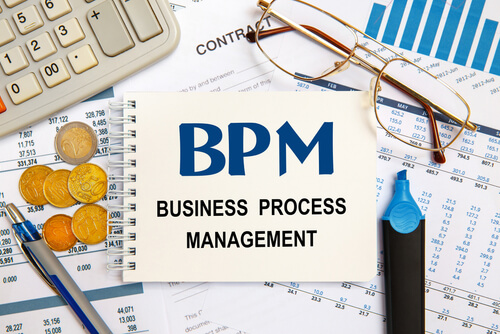The lifespan of so-called ERP (Enterprise Resource Planning) systems has continuously been evolving and taking different dimensions. In the late 90’s and early 2000, there were close to a dozen ERP products ruling the business world. It catered many industries, with their specific modules, such as Human Resource Management (HRM), Financial and Accounting Management, Supply Chain Management (SCM), Sales and Distribution Management (SDM), Manufacturing & Warehouse Management, Customer Relationship Management (CRM) and many more.
ERP and BPM streamlining the business processes
The period 2000-2010, witnessed large acquisitions and mergers of ERP vendors and at the end of 2010, only a few ERP product companies existed, in the market. JD Edwards, known for its strong Manufacturing modules (Plan-To-Build), was acquired by PeopleSoft, known for its HRMS (Hire-To-Retire) and Campus management solutions. Right after this acquisition, Oracle, which was known for its Oracle Financials and Budgets (Record-To-Receipt), acquired PeopleSoft and Siebel, known for its CRM (Acquire-To-Retain) capabilities. It finally became a strong ERP product, with a combination of Financials, Human Resources, Manufacturing, and Customer Relationship Management (CRM) besides its strong Database capabilities. The other big player has been SAP, still.
However, both SAP and Oracle, besides their large-sized process modules and product portfolios, they have always been offering their BPM (Business Process Management) modules, as part of their Enterprise suite of applications, and as a Package.
Their BPM modules focus more on workflows and rule-based engines, to streamline the business process and subprocess, based on well-defined business strategy, for improved process efficiency and higher productivity. They are also focusing on process standardization, orchestration, optimization, extension, and innovation.
Besides SAP and Oracle, other BPM products are Appian iBPM, Pega BPM, Microsoft BPM suite, IBM BPM Process Manager, Wonderware Skelta BPM, Savvion BPM Progress Manager, and Red Hat Process Automation Manager and many more. All of them focus on a specific target segment of the industry.
But still, Manual work was continuing, and time-consuming
Even though deploying ERP and BPM modules across all business functions, there was always a need for “human touch”. It required considerable “Human Efforts”, for activities such as creating requests, reviewing requests based on a checklist, approval of requests, downloading the reports, comparing reports, and finally emailing the reports to the concerned stakeholders.
It required a considerable amount of human time and efforts and observed numerous disadvantages like human error, misplace of documents, misspelt of input information, wrong data keyed and more. Once found, the rework to rectify the wrong data, keyed in, also took some considerable time.
The industries were desperately looking for technology to help reduce manual efforts and time.
The Arrival of RPA
Even after streamlining the business processes and workflows with ERP and BPM products’ help, the need for the human effort has become inevitable, which is where the Robotic Process Automation (RPA) arrived.
RPA tools are known for their tactical, focused, and agile approach for accelerating the manual processes. RPA helps employees from mundane, repetitive tasks and leverages their human skills for more important tasks, where human-touch is necessary.
The focus of RPA is the automation of high-volume tasks using software bots. This is a much narrower focus than that of business process management yet highly effective technology. Simply put, RPA hands, individual tasks, and activities, over to software robots to streamline and automate. At the same time, BPM takes an entire business process and automates it from start to finish, at the process level.
There are RPA and BPM tools offered by OEM, and many opensource tools are also available. The most widely used RPA tools are Blue Prism, UiPath, Automation Anywhere, Pega, Kofax, AntWorks, Work Fusion, Sofomotive, OpenSpan, Micro Flow, RASA and more.
Deploying RPA on optimized ERP/BPM
Strategic approaches for implementing BPM is different from deploying the RPA, as BPM is a discipline, whereas RPA is a technological tool. To leverage the benefits of “True Automation”, there are experts, who suggest combining both BPM and RPA with the help of Cognitive computing such as Artificial Intelligence (AI) and Machine Learning (ML), towards the “Hyper Automation Journey”.
There are attended RPA bots require human intervention while performing automation processes, Unattended Bots, which are intelligent having decision-making capabilities and finally, the Hybrid RPA bots having combined capabilities of both attended and unattended bots.
The wise strategy could be, to deploy the RPA procedures, after optimizing the business process and workflows with the help of ERP and BPM functionalities, as RPA is fully capable of automating the manual and repetitive tasks arising out of ERP and BPM.
Choosing the right tools for max Automation Potential
It becomes so clear that choosing the right automation tool is the Key Success Factor. Each of the automation tools has different fitments for the end-user community’s current application landscape, including varied applications, fragmented processes, and Inter-connectivity between inside and outside systems.
- If the nature of work is deterministic and with high Process FTE density and low process fragmented, but too many workflows are involved, then choose to implement BPM.
- If the nature of work is deterministic and with high Process FTE density and low process fragmented, but too many repetitive UI actions are involved, then choose to deploy RPA.
- If the nature of work is deterministic and with high Process FTE density and low process fragmented, but too many paper-based actions are involved, then choose to deploy OCR.
Automation Formula
<Start
If
your organization’s AS-IS condition is a combination of all above selection criteria,
then
choose the right processes and deploy the right automation tools.
End>
Summary
Select to implement the right ERP/BPM for creating process, business rules, workflows, monitoring business activities, auto-mailers and managing forms.
But choose the right RPA to automate,
- Processing of tasks and activities
- Processing of unstructured data-acquisition
- Intelligent Correlation (Filtering, Classification, Root cause analysis and Prediction)
- Digital/Human work optimization (Intelligent dispatch and Escalations)
- Intelligent Monitoring (Infrastructure, Applications, and logs)
- Intelligent Automation (end-to-end Automation using a mix of RPA and RDA).
Leveraging the strong functionalities of both BPM and RPA will yield maximum Automation potential, while ERP/BPM, as a discipline, is trying for streamlining the process, RPA, on the other hand, is automating the tasks, transactions and activities, to 100% accuracy.
The real automation happens, when most of the manual based tasks, transactions and activities are done, without any manual efforts, leading to 100% accuracy, quick processing time and available to work 24×7.
We, the Digital Process Automation (DPA) CoE at, Happiest Minds Technologies Limited, are committed to assuring our best Digital Automation technology and DPA process consulting services, for “Real Digital Automation Journey”.
Intelligent Process Automation is an ongoing journey towards Continuous Improvement (CI).

has been with the DPA CoE at Happiest Minds Technologies Limited, as Director – Digital Automation. He has over 25+ years of experience across Enterprise Resource Planning (ERP), Business Process Automation (BPA) and Robotic Process Automation (RPA) including Conversational AI, Virtual Agents platforms and Optical Character Recognition (OCR). He has provided Consulting to many organizations in transforming to Digital Automation and helped them achieve direct saving on time and efforts by 45-65% while keeping the accuracy to ~100%, without disturbing the existing IT application landscape and business, across North America, Europe, Singapore, Thailand and China. Rajkumar has published 10+ articles in International Conferences, including few blog papers on Digital Automation, to his credit.







